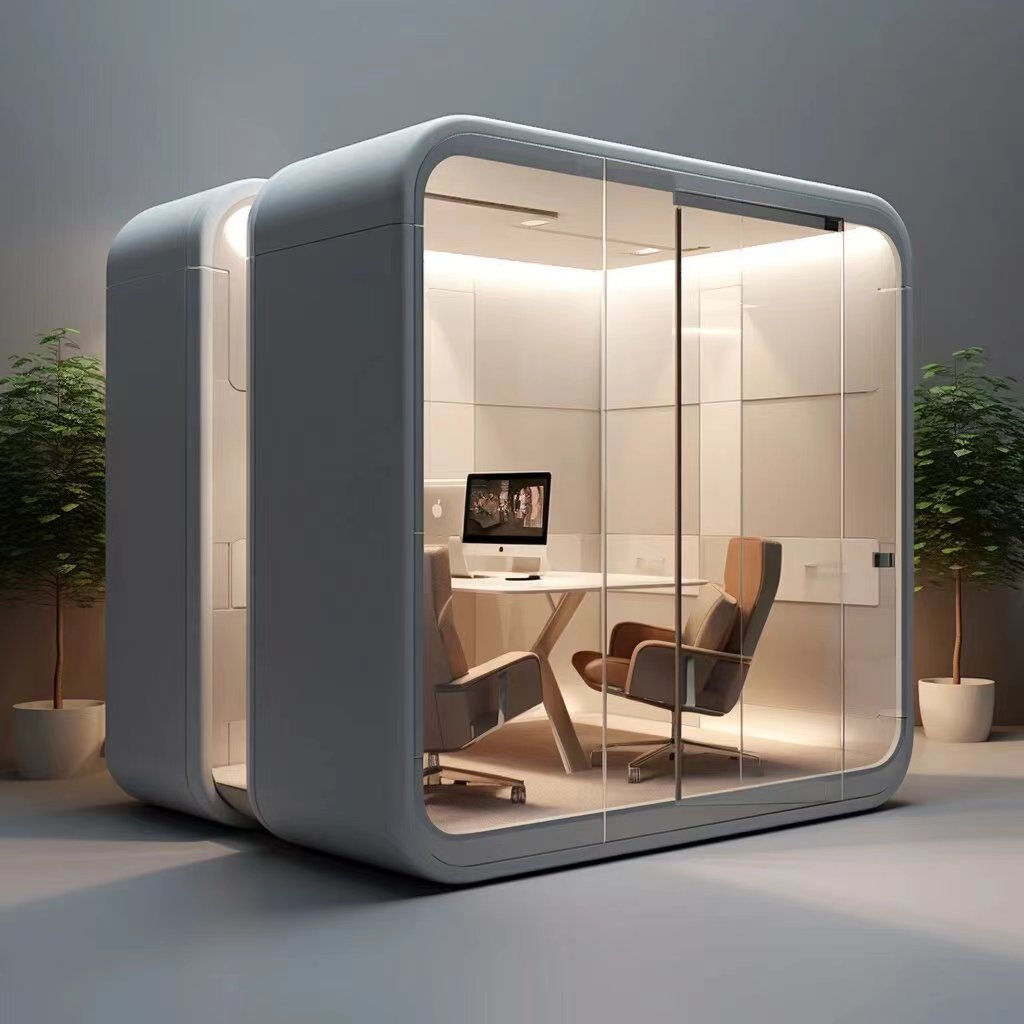What Makes a Soundproof Cabin a Game-Changer for Work, Studio, and Home Use?
2025-10-17
In a world increasingly filled with ambient noise—urban commotion, household chatter, HVAC systems, traffic—how can individuals carve out truly quiet spaces for focus, recording, or relaxation? A Soundproof Cabin offers a turnkey solution: an acoustically treated, insulated enclosure that transforms any environment into a near-silent sanctuary.
What Is a Soundproof Cabin (and What Can It Do)?
Definition and Core Capabilities
A soundproof cabin is a self-contained module (often prefabricated) engineered to suppress external noise and internal sound leakage. Built with layered walls, acoustic materials, and structural isolation, it forms an acoustic “bubble” within a larger space (office, garage, studio, home) that delivers significantly reduced sound transmission both in and out.
Typical use cases include:
-
Voice recording studios / podcast booths
-
Music practice or rehearsal rooms
-
Quiet work pods / open office retreats
-
Home offices in noisy environments
-
Meditation or therapy rooms
Key Benefits
-
Significantly lower ambient noise inside (often by 30–60 dB)
-
Prevents sound leakage to surrounding areas
-
Modular and relocatable
-
Faster setup than conventional room renovation
-
Controlled acoustic environment for clarity
Typical Product Specifications
Below is a representative specification set for a mid-sized soundproof cabin:
| Parameter | Typical Value / Range |
|---|---|
| External dimensions | e.g. 2m × 1.5m × 2.2m (can scale larger) |
| Wall construction | Multi-layer (gypsum, acoustic foam, mass-loaded vinyl) |
| Sound Transmission Class (STC) | 45–60+ dB (depending on design) |
| Internal reverberation time (RT60) | 0.2–0.5 s (tunable via acoustic panels) |
| Door type / seal | Airtight jamb with acoustic seal and double seals |
| Window (optional) | Double or triple glazing with acoustic laminate |
| Ventilation / HVAC | Low-noise silenced ventilation or duct system |
| Electrical / lighting | LED lighting, power outlets, wiring paths |
| Weight / portability | Varies (e.g. 500–1200 kg module) |
These parameters help clients compare models and assess performance claims.
Why Do Individuals and Businesses Demand Soundproof Cabins?
Rising Need for Acoustic Privacy in Shared Environments
Open offices, co-working spaces, and dense urban living make quiet zones scarce. Long meetings, recording sessions, or focused work suffer from distractions. A soundproof cabin offers a private, noise-isolated environment within shared space.
Enhanced Audio Quality for Creators
Podcasters, musicians, voiceover artists, and video producers require consistent, high-quality recordings without ambient bleed or external disturbances. Traditional room treatments often struggle to fully isolate. A purpose-built cabin brings professional-grade isolation.
Faster Deployment vs Traditional Construction
Renovating a room (floating floors, double walls, acoustic treatment) can be costly, time-consuming, and disruptive. Soundproof cabins are prefabricated and modular, enabling quicker installation and minimal disruption to existing infrastructure.
Scalability and Flexibility
Organizations may need multiple quiet pods or recording booths. Because cabins are modular, scaling up or relocating them is relatively straightforward—no need for major rebuilds.
Improved Productivity and Well-Being
Quiet environments reduce cognitive load, help concentration, and lower stress. For remote workers or knowledge professionals, access to a soundproof cabin can yield more effective work sessions and better work–life balance.
How Do Soundproof Cabins Work and How Should One Select Them?
Underlying Principles of Acoustic Isolation
Mass + Damping + Decoupling
-
Mass: Heavier wall layers (e.g. dense board, mass-loaded vinyl) block sound transfer.
-
Damping: Viscoelastic or constrained-layer materials dissipate vibrational energy.
-
Decoupling / Isolation: Inner frames mounted separately from outer frames prevent direct vibration paths.
Absorption and Diffusion
Inside the cabin, sound reflections are managed via acoustic foam, panels, diffusers, and bass traps. This ensures a controlled internal reverberation rather than bare echo.
Airtight Seals
Doors, windows, electrical passthroughs all employ acoustic seals or gaskets to minimize leakage. Even small gaps (1–2 mm) can drastically degrade isolation.
Silenced Ventilation
To maintain air circulation without compromising isolation, ventilation ducts employ mufflers, baffles, acoustic labyrinths, and low-noise fans.
Selection Criteria and Decision Factors
Required STC / Isolation Level
Define the target sound reduction based on surrounding noise and application. For example, heavy urban traffic may demand STC 55+, whereas a quiet office context might allow STC 45.
Internal Acoustic Profile
Decide whether the cabin will be used for voice, musical instruments, mixing, or silent work. Tailor internal panels and diffusion accordingly.
Space Constraints and Layout
Check the available footprint, ceiling height, door swing space, and headroom limitations. Modular rectangular formats are common, but custom shapes may be needed.
Ventilation & HVAC Integration
If sessions exceed 30 minutes or multiple occupants, adequate ventilation is critical. Evaluate how the cabin’s ventilation system integrates with site HVAC or independent ducting.
Electrical / Connectivity Requirements
Assess requirements for power outlets, data cabling, lighting, and monitor mounts. Pre-wiring at manufacturing reduces onsite modifications.
Portability and Reusability
If relocation is a possibility, check the weight, modular join systems, and whether the cabin can be broken down and moved.
Certification and Testing
Prefer models tested in lab settings (ASTM, ISO, or local acoustic labs) with published data. Ask for transmission loss curves across frequency bands.
Installation and Commissioning Steps
-
Site Preparation: Level floor, ensure no major mechanical vibration sources on mounting plane.
-
Base Frame Installation: Mount vibration isolators if needed (neoprene pads, springs).
-
Panel Assembly: Assemble wall, ceiling, and floor panels, aligning internal and external layers carefully.
-
Sealing Edges: Apply acoustic sealant, gaskets around seams, door frames, and cable penetrations.
-
Door & Window Fit: Test door closings, verify seal integrity, test for leaks.
-
Ventilation Setup: Connect ductwork, install mufflers and silent fan units.
-
Internal Treatment: Install acoustic panels, bass traps, diffuser modules as designed.
-
Electrical & Testing: Wire lighting, outlets, conduct acoustic testing (e.g. pink noise sweep) to validate performance.
Maintenance and Usage Tips
-
Periodically check and re-tighten door seals and panels
-
Inspect ventilation filters and fan bearings
-
Avoid drilling additional holes (which may breach acoustic layers)
-
For high SPL instrument use, monitor internal vibration or microleaks
Future Trends, Use Cases, and Market Outlook
Advances in Smart Acoustic Control
Future cabins may integrate active noise control (ANC) where embedded microphones detect external noise and generate inverse-phase cancellation. Such systems can supplement passive isolation, particularly at lower frequencies.
Hybrid Office Models and Acoustic Pods
As hybrid work becomes standard, organizations will deploy more acoustic pods (soundproof cabins) within shared offices. These serve as meeting pods, focus rooms, phone booths, or hybrid event boxes.
Eco-Friendly and Lightweight Materials
Research into recycled acoustic composites, nano-composite panels, and foam composites with lower density but high performance can reduce weight and environmental impact while maintaining efficacy.
Modular Multi-Unit Soundproof Suites
Instead of single cabins, modular clusters may connect to form small suites—e.g. control room + vocal booth + lounge pods—while maintaining acoustic isolation and internal connectivity.
On-Demand Acoustic Rental Services
In event spaces, broadcast studios, or temporary setups, clients may rent soundproof pods for short term (e.g. conferences, festivals, remote broadcasting). Rapid-deploy cabin systems could capture that market.
4.6 Price Trends and Market Growth
As production scales and acoustic materials evolve, cabin pricing will likely become more accessible. Demand from creators, remote workers, educational institutions, and enterprises will fuel steady market growth.
Common Questions about Soundproof Cabins (FAQ)
Q1: How much noise reduction can a soundproof cabin actually deliver?
A1: Depending on design, a well-constructed soundproof cabin can offer 30 to 60+ dB of noise reduction (STC 45 to STC 60+). In practical terms, loud traffic or urban noise at 70-80 dB can drop to 10-30 dB inside, rendering a quiet, usable environment.
Q2: Will ventilation or air movement degrade acoustic isolation?
A2: If not designed properly, ventilation is a weak point. But using silenced ducts, acoustic labyrinths, mufflers, and low-noise fans can preserve isolation. A well-engineered ventilation system keeps the noise floor low without compromising air quality.
Summary & Brand Statement
A soundproof cabin is more than just a box—it’s a precision acoustic tool that transforms noisy environments into serene, functional spaces. Whether for music production, focused work, or hybrid office models, these cabins give both privacy and performance. Key selection hinges on isolation level (STC), internal acoustic treatment, ventilation, and modular flexibility.
As trends progress toward smart acoustics, greener materials, and scalable pod networks, the role of soundproof cabins will only become more central in modern space design.
Cymdin, with its years of acoustic engineering expertise, offers high-quality, customizable soundproof cabin solutions tailored to your needs. To explore options, request testing data, or get a quote, contact us.





